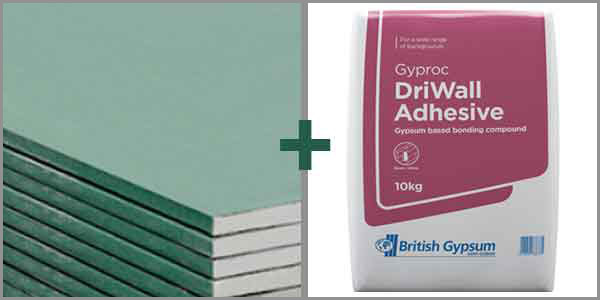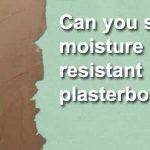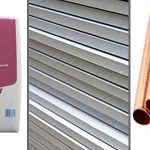There are many reasons why you might choose to use moisture resistant plasterboard. This might include the type of room, or even the type of wall, such as a cold or damp external wall.
This type of board has a unique design. Which means that they can withstand moisture more than a standard plasterboard. Standard boards can absorb water quite quickly as they are not designed to be water resistant.
Over time, this will cause them to weaken and eventually they will fail and need replacing. Due to this, if you believe moisture may be an issue, you may decide to use moisture resistant plasterboard. However, one concern may be if they need installing differently
For example, can you dot and dab moisture resistant plasterboard?
Just like a standard plasterboard, it is possible to dot and dab moisture resistant boards. They can be used for walls and ceilings and one of the most common ways to install on solid walls, is using dot and dab adhesive.
Dot and dab involves using a dry-wall adhesive directly on the wall. You can apply this in blobs across the surface before the moisture resistant board is put in place. This method is very effective on walls. However, a different approach should be used when fixing to ceilings.
When fixing any board to a ceiling, dot and dab will not be effective, in fact it could be quite dangerous. Instead, dry wall screws should be used to fix to a ceiling, as they will attach the boards securely.
What is Moisture Resistant Plasterboard Used For?

Standard plasterboards are suitable for most rooms around the home, but there are certain areas where they are not the best choice. These include bathrooms, wet rooms, and kitchens. This is because these rooms tend to have higher humidity.
High humidity will cause damage to standard plasterboards. They will absorb the moisture and become weaker, which could lead to future problems. This is where moisture resistant plasterboards are an ideal solution.
In kitchens and bathrooms, the walls are exposed to excess moisture. This includes moisture in the air and water in the form of splashes and spills. So, with this excess moisture, it’s important that you use plasterboards that are fit for purpose.
Moisture resistant plasterboards are manufactured differently. They are made using water repellent additives and that enables them to withstand moisture.
When fixing moisture resistant plasterboards to masonry walls, the usual method is to dot and dab. This will mean that you can use a dry-wall adhesive directly on the wall. This adhesive will then form a strong bond with the plasterboards, holding them firmly in place.
If you are fixing them to ceilings, then you should use mechanical fittings. This means that you will secure them using drywall screws. These can be fixed to timber joists and rafters.
Using dot and dab provides an extremely secure bond to the original surface. Therefore, once the plasterboard has been fixed in place, it is then perfectly fine to tile on top of the boards.
Alternatives to Dot and Dab Moisture Boards
It is important to remember that dot and dab is not the only option. The method you use might depend on the condition of the walls. You might also want to choose a different method on an external wall that is cold and damp.
An alternative method to dot and dab is to use timber battens. The battens are lengths of timber that you fix to the original walls using screws. This creates a secure frame that you can then attach the plasterboards to. Instead of using dot and dab, you then secure the moisture resistant plasterboard using drywall screws.
This is also a good method if you want to install insulation before you fix the plasterboard in place. The battens allow you to create a void between the wall and the plasterboard, making it suitable for insulation.
It is common to tile in kitchens and bathrooms, so instead of moisture resistant plasterboard, you might instead opt to use backerboards. These are prefabricated sheets that are made using cement-based materials. Backerboard will enable you to achieve a good finish, and just like moisture boards, they are also water resistant. They can be found in two thicknesses – 6mm and 12mm. The thinner board is used on flooring and the thicker board is used on walls.
When you install backerboards, you have several options available. You can fix them to stud walls by screwing them directly to the timbers. It’s also possible to screw them directly to a solid wall, using wall plugs, screws, and specialist washers at 300mm spacing.
You can also opt to use tile adhesive to fix them in place or you can use a drywall foam. But it is important to remember, you will need to make any joints watertight using waterproof joint tape.
Can You Plaster Moisture Resistant Plasterboard?
While moisture resistant plasterboard is mostly tiled, you might think about plastering them instead. If this is the case, you will need to make sure that the plaster bonds to the board correctly.
In some cases, it is possible to use a skim plaster directly onto the boards. On small jobs, this is likely to work fine, but it is still recommended that you use a bonding agent. This is because moisture resistant boards do not have the right suction. Using a bonding agent, will enable you to create a good key that helps the plaster to bond with the board.
Conclusion
Moisture resistant plasterboards are a good solution in kitchens and bathrooms where you wouldn’t use normal boards. This will ensure that the boards are protected from the extra moisture, leaving your walls and tiling looking good.
When installing your plasterboards, you can use dot and dab. But it’s important that you make sure that the wall is suitable for this method. If not, there are other options available. This means you can fix them differently, or use an alternative board such as backerboards
If everything is right, then using dot and dab is one of the most common methods of installing moisture resistant plasterboards. However, it’s important to remember that there are always alternative options depending on your situation.




